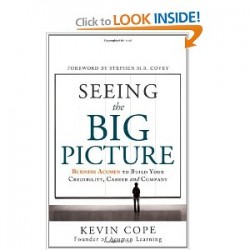Seeing the Big Picture: Business Acumen to Build your Credibility, Career, and Company by Kevin Cope
Okay, I’ll admit it. I requested a copy of Seeing the Big Picture by Kevin Cope because I wanted to pick up a few tips. I have always had a weakness of working “in” the business as opposed to working “on” the business. That applies to this blog and to my day job. I get bogged down in the day to day details and never take the time to step back, look at the wider landscape, and see what things could be improved on a higher level.
I was a little skeptical that I wasn’t going to get what I wanted when the book started with discussions on cash flow and net profits. However, I was pleasantly surprised by the great content and probably took more notes in this book that I have in many others dedicated exclusively to the HR/recruiting space. And that, in my opinion, is a very good thing.
 Highlights from Seeing the Big Picture
Highlights from Seeing the Big Picture
- On page 25 the author offers a challenge to everyone. He mentions cash flow impact and how each area of the company can impact that, from accounting to marketing and beyond. At the end of the section he offers a catch-all: everyone can reduce expenses and reduce cash outflow by cutting waste… If you can contribute to your company’s cash flow you will be valued. Think about it–how can you have a positive impact on cash flow in your current role? How can you quantify that? Would it make you look more appealing as a leader within the organization?
- In the chapter on assets, he touches on employee productivity. I once heard a speaker say that employee productivity is the uncharted frontier for HR professionals. With the amount of money spent on motivating and rewarding employees, I’d have to say that’s a valid point. The discussion here in the book (page 60) on workforce productivity is fantastic, because he also warns against productivity at the expense of customer satisfaction. Gotta balance those needs.
- An interesting HR correlation to a Warren Buffet saying: if you don’t understand how something works don’t invest in it. I would say that if you don’t understand how a company makes money, you shouldn’t be working there. I remember an awkward phase when I started my last job where I didn’t understand where the money came from that kept the company afloat. Finally I took the time to understand (at least at a basic level) where our funding came from and the general percentages from various sources. It helped me to fully understand the implications if someone mentioned that x source was going to fall 50%. If it was our smallest revenue steam, it wasn’t as much of a worry; if it was our largest, it was time to look for another job. :-)
- People practices matter. The author dug into a Circuit City mess where, in order to reduce expenses, the company cut its most senior customer service professionals to hire in new ones at lower wages. The new ones didn’t have the knowledge or rapport with customers, which led to lower sale and decreased performance for the company. Think through your decisions carefully-everything has some sort of consequence, even if it isn’t immediate.
- Company growth phases are fairly standard. Startup, growth, maturity, decline. But what about the types of employees required in each phase of growth? I think it can shift over time. New companies look for people to take risks, work long hours, etc. Mature companies want to maintain what they have and reduce risk, which means hiring an entirely different set of employees. This one is worth a future post to itself…
- Companies need heroic stories to drive their culture and give their people high ideals. Corporate legends? Sounds familiar…
- The best companies have a way of attracting the best people, and the best people help create even better companies.Â
- One company requires its new employees to attend approximately 250 hours of training before they fully take over their new role. FYI: that’s about 6 and a half weeks of training. I got about five hours when I started my job. And that was spread over several months of quick conversations. None of it was particularly structured or prescribed. Imagine what the cost is, but also imagine what the feeling would be like to know that your company invested that much time and effort into helping you be successful on your first day on the job. Inspiring.
Conclusion
If you know you have a weakness with not seeing the bigger picture, this book can help. If you’re looking to move into a higher level leadership role and want to be able to converse on topics like cash position, assets, financial statements, etc., this book can help.
HR is an area that sorely needs some “big picture” thinking, and I think it would be valuable as a career tool if this type of content was required reading on an annual basis for HR pros. You are not a silo–every decision you make affects the key areas of the company as described in this book. Click here to get your copy of the book.
Pingback: Measuring the ROI of HR Programs is Critical: Here’s How Patagonia Does It | upstartHR